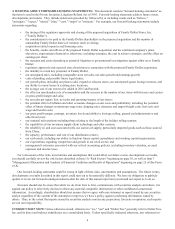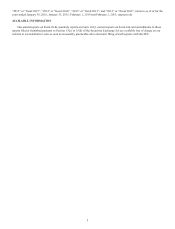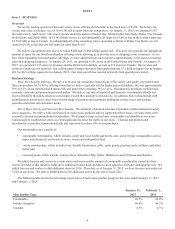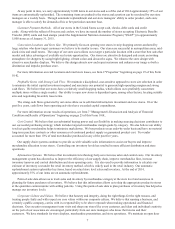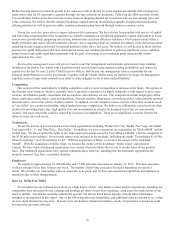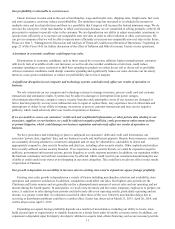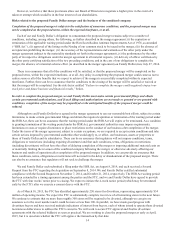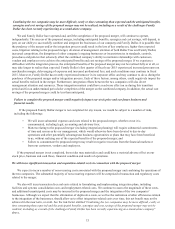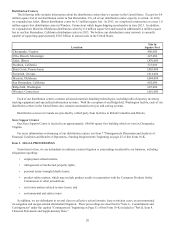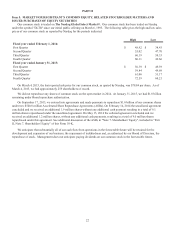Dollar Tree 2014 Annual Report Download - page 28
Download and view the complete annual report
Please find page 28 of the 2014 Dollar Tree annual report below. You can navigate through the pages in the report by either clicking on the pages listed below, or by using the keyword search tool below to find specific information within the annual report.12
and approvals. It remains difficult for third party developers to obtain financing for new projects due to the recent turmoil in
the financial markets. We also open or expand stores within our established geographic markets, where new or expanded
stores may draw sales away from our existing stores. We may not manage our expansion effectively, and our failure to
achieve our expansion plans could materially and adversely affect our business, financial condition and results of operations.
Risks associated with our domestic and foreign suppliers from whom our products are sourced could affect our financial
performance.
We are dependent on our vendors to supply merchandise in a timely and efficient manner. If a vendor fails to deliver on
its commitments due to financial or other difficulties, we could experience merchandise shortages which could lead to lost
sales or increased merchandise costs if alternative sources must be used.
Merchandise imported directly accounts for approximately 39% to 41% of our total retail value purchases. In addition,
we believe that a portion of our goods purchased from domestic vendors is imported. China is the source of a substantial
majority of our imports. Imported goods are generally less expensive than domestic goods and increase our profit margins. A
disruption in the flow of our imported merchandise or an increase in the cost of those goods may significantly decrease our
profits. Risks associated with our reliance on imported goods may include disruptions in the flow of or increases in the cost of
imported goods because of factors such as:
• raw material shortages, work stoppages, strikes and political unrest;
• economic crises and international disputes;
• changes in currency exchange rates or policies and local economic conditions, including inflation in the country
of origin; and
• failure of the United States to maintain normal trade relations with China.
We could encounter disruptions in our distribution network or additional costs in distributing merchandise.
Our success is dependent on our ability to transport merchandise to our distribution centers and then ship it to our stores
in a timely and cost-effective manner. We may not anticipate, respond to or control all of the challenges of operating our
receiving and distribution systems. Additionally, if a vendor fails to deliver on its commitments, we could experience
merchandise shortages that could lead to lost sales or increased costs. Some of the factors that could have an adverse effect on
our distribution network or costs are:
• Shipping disruption. Our oceanic shipping schedules may be disrupted or delayed from time to time.
• Shipping costs. We could experience increases in shipping rates imposed by the trans-Pacific ocean carriers.
Changes in import duties, import quotas and other trade sanctions could increase our costs.
• Diesel fuel costs. We have experienced volatility in diesel fuel costs over the past few years.
• Vulnerability to natural or man-made disasters. A fire, explosion or natural disaster at a port or any of our
distribution facilities could result in a loss of merchandise and impair our ability to adequately stock our stores.
Some facilities are vulnerable to earthquakes, hurricanes or tornadoes.
• Labor disagreement. Labor disagreements, disruptions or strikes may result in delays in the delivery of
merchandise to our distribution centers or stores and increase costs.
• War, terrorism and other events. War and acts of terrorism in the United States, the Middle East, or in China or
other parts of Asia, where we buy a significant amount of our imported merchandise, could disrupt our supply
chain or increase our transportation costs.
• Economic conditions. Suppliers may encounter financial or other difficulties.
Our profitability is affected by the mix of products we sell.
Our gross profit margin could decrease if we increase the proportion of higher cost goods we sell in the future. In recent
years, the percentage of our sales from higher cost consumable products has increased and we can give no assurance that this
trend will not continue. As a result, our gross profit margin could decrease unless we are able to maintain our current
merchandise cost sufficiently to offset any decrease in our product margin percentage. We can give no assurance that we will
be able to do so.
Pressure from competitors may reduce our sales and profits.
The retail industry is highly competitive. The marketplace is highly fragmented as many different retailers compete for
market share by utilizing a variety of store formats and merchandising strategies. We expect competition to increase in the




